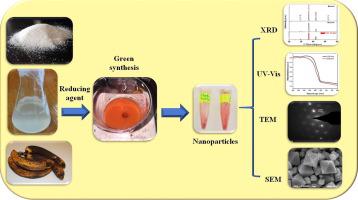Our official English website, www.x-mol.net, welcomes your feedback! (Note: you will need to create a separate account there.)
Biosynthesis of cuprous oxide using banana pulp waste extract as reducing agent
Fuel ( IF 7.4 ) Pub Date : 2021-02-01 , DOI: 10.1016/j.fuel.2020.119152 S. Torres-Arellano , O. Reyes-Vallejo , J. Pantoja Enriquez , J.L. Aleman-Ramirez , A.M. Huerta-Flores , Joel Moreira , Jesus Muñiz , Laura Vargas-Estrada , P.J. Sebastian
Fuel ( IF 7.4 ) Pub Date : 2021-02-01 , DOI: 10.1016/j.fuel.2020.119152 S. Torres-Arellano , O. Reyes-Vallejo , J. Pantoja Enriquez , J.L. Aleman-Ramirez , A.M. Huerta-Flores , Joel Moreira , Jesus Muñiz , Laura Vargas-Estrada , P.J. Sebastian

|
Abstract In this study we synthesized cuprous oxide by biosynthesis process, replacing conventional reducing agents like sodium borohydride (NaBH4), hydrazine (N2H4) etc. with banana pulp waste extract. The particles obtained are highly oriented along the plane (1 1 1) and present octahedral morphology, which is excellent for electrical transport and photocatalytic degradation. TEM images show that particles are well crystallized and polycrystalline in nature with sizes in the range of 1–4 µm. According to FTIR spectra no remnants of banana pulp waste extract are present in the synthetized particles. The band gap calculated is 2.07 eV, which is suitable for solar conversion applications.
中文翻译:

以香蕉果肉废料提取物为还原剂生物合成氧化亚铜
摘要 在本研究中,我们通过生物合成法合成氧化亚铜,用香蕉果肉废料提取物代替硼氢化钠 (NaBH4)、肼 (N2H4) 等常规还原剂。所获得的颗粒沿平面 (1 1 1) 高度取向并呈现八面体形态,这对于电传输和光催化降解而言是极好的。TEM 图像显示颗粒在性质上结晶良好且为多晶,尺寸在 1-4 µm 范围内。根据 FTIR 光谱,合成颗粒中不存在香蕉果肉废料提取物的残留物。计算出的带隙为 2.07 eV,适用于太阳能转换应用。
更新日期:2021-02-01
中文翻译:

以香蕉果肉废料提取物为还原剂生物合成氧化亚铜
摘要 在本研究中,我们通过生物合成法合成氧化亚铜,用香蕉果肉废料提取物代替硼氢化钠 (NaBH4)、肼 (N2H4) 等常规还原剂。所获得的颗粒沿平面 (1 1 1) 高度取向并呈现八面体形态,这对于电传输和光催化降解而言是极好的。TEM 图像显示颗粒在性质上结晶良好且为多晶,尺寸在 1-4 µm 范围内。根据 FTIR 光谱,合成颗粒中不存在香蕉果肉废料提取物的残留物。计算出的带隙为 2.07 eV,适用于太阳能转换应用。



























 京公网安备 11010802027423号
京公网安备 11010802027423号